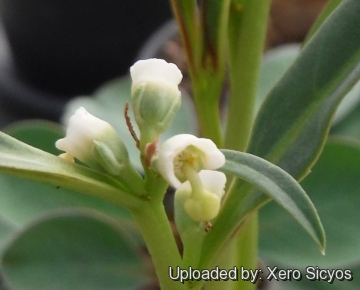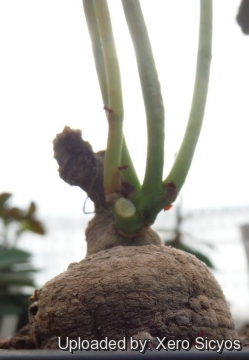




Your support is critical to our success.
- Encyclopedia of SUCCULENTS
- Encyclopedia Index
- Families
- Genera
- Species
- Euphorbiaceae
- Euphorbia
- Caudiciforms
Since 4 Aug 2013

Origin and Habitat: Monadenium crispumSN|29607]]SN|29607]] is endemic to Tanzania (Tanga, and Pangani Districts) not known elsewhere
Altitude range: 30-700 metres above sea level.
Type locality: Tanzania, Tanga District, Amboni Forest.
Habitat and ecology: Rocky slopes and rocky hilltops in deciduous forest.
Synonyms:
- Euphorbia neocrispa Bruyns
- Monadenium crispum N.E.Br.
Euphorbia neocrispa Bruyns
Taxon 55: 413 2006.
Synonymy: 3
- Euphorbia neocrispa Bruyns
- Monadenium crispum N.E.Br.
- Monadenium intermedium P.R.O.Bally
Description: Euphorbia neocrispa (Monadenium crispum) is a gabrous perennial sparsely-branched herb to 75 cm high, with a tuberous root (caudex) about 4 cm in diameter. The leaves are ovate-lanceolate, and slightly succulent. The flowers (cyathia) are creamy white in the axils of the upper leaves.
Stems: One to few probably annual and arising from a tuberous rootstock, 12-75 cm high, at first erect but with time often trailing along the ground and rooting where they touch the ground, unbranched, subfleshy, cylindrical, 2-4 mm thick, with obscure longitudinal ridges, glabrous or sparsely and minutely papillose. Leaf-scars alternate, spirally arranged, 15-42 mm apart.
Rootstock: Tuberous.
Leaves: Alternate, very spreading or perhaps slightly deflexed, slightly fleshy, base tapering to a short petiole less than 1 cm long, 4-8(-10) cm long, (1-)3(-4) cm broad, obovate to linear-lanceolate, apex obtuse, crisped or denticulate with rounded teeth at the margins, glabrous on both sides. Midrib prominent below, but not keeled, veins not prominent, ascending. Stipules triangular, 1 mm long, brown.
Inflorescences (Cymes): Cymes subsessile, 3-4(-10) mm long, once, perhaps twice, forked in the axils of the upper leaves and terminal, bearing 1–3 involucres. Peduncles 3-10 mm long, cymebranches 2-5 mm long. Bracts equalling the involucre, free to the base, 3,75-4,25 mm long, 2-4 mm broad, oblong, rounded and apiculate at the apex, slightly keeled down the back, glabrous, green.
Flowers (cyathia): about 3-4.5 mm long and about 5 mm wide, with funnel-shaped involucres open to half-way down in front, truncate at the top, with a slightly thickened entire margin, glabrous. Glandular rim spreading,1.5 mm high, margin entire to crenulate, shallowly notched, pink. Lobes rounded, a 1.3 x 1.3 mm. Male flowers: bracteoles filamentous, plumose. Stamens 3.5 mm. long. Female flower: perianth an obscurely 3-lobed rim below the ovary. Ovary trigonous, with a slight simple keel down each angle, exserted on a recurved pedicel, glabrous. Styles free to the base 0.8 mm long, with thickened rugulose minutely 2-lobed at the apex scarcely bifid apices.
Fruit (Capsule): Exserted on a reflexed pedicel 4 mm long, obtusely 3-lobed, 4-5.5 long and 5-6 mm in diameter, glabrous.
Seeds: 4-angled, oblong, 3.5 x 2 mm, truncate at each end, minutely tuberculate all over and with a furrow down one side.
Similar species: Euphorbia neocrispaSN|29606]]SN|29606]] to Euphorbia crenata (Monadenium crenatum), in appearance, but the leaves are not wing-keeled beneath, the peduncles are much shorter and the involucre is entire at the rim.
Bibliography: Major references and further lectures
1) Urs Eggli “Illustrated Handbook of Succulent Plants: Dicotyledons” Springer Science & Business Media, 2002
2) J. G. Baker, with additions by C. H. Wright. “Flora of Tropical Africa”, Vol 6, Part 1, 1913
3) Susan Carter, A. R. Smith “Flora of Tropical East Africa - Euphorbiaceae” volume 2 CRC Press, 01 June 1988
4) Peter R. O. Bally “The Genus Monadenium: With Descriptions of 21 New Species” Benteli, 1961

Euphorbia neocrispa Photo by: Xero Sicyos

Euphorbia neocrispa Photo by: Xero Sicyos
Cultivation and Propagation: Monadenium crispumSN|29607]]SN|29607]] (Euphorbia neocrispaSN|29606]]SN|29606]]) is an interesting addition to a collection, but rarely seen in cultivation.
Growth rate: It grows well, though very slowly, but it possible to increase the speed of growth to some extent by providing adequate amount of water, warmth, and fertilizer during the active growing season, but it’s susceptible to rotting if too wet.
Exposure: It needs light shade, but the caudex should be in the shade, while the leaves prefer some sun. Avoid direct blasting sun in summer. Bright light if grown indoors.
Soil: In pots it needs a very porous potting medium (add pumice, vulcanite, and perlite). It does better in a rather acidic soil.
Waterings: Water frequently while plant is in full growth, but keep dry during the winter after the branches have died back. It rot easily and do NOT like a lot of water when it has no leaves.
Fertilizer: Benefits from moderate doses of a well-balanced, slow-release fertilizer.
Frost tolerance: Due to its African origin keep warm in winter, the minimum safe average temperature is 15°C, although it can go lower for short periods. It can be grown outdoors in frost-free climates, need anyway to kept above 10°C and dry in winter. It is very prone to rot in cool, wet conditions. USDA Zone 10-12, but does very well in containers.
Manteinance: Repot every two years. It like pots with generous drain holes. In the winter, the branches die back and should be cut back to encourage rebranching, to maintain an attractive shape and to ensure caudex habit.
Pest and diseases: White meldew, mould and other fungi.
Propagation: The species can be propagated by both seeds and cuttings. The plants for seed production are generally grown from cuttings since these bloom more freely. The plants for decoration are grown from seed since they develop a caudex.
| Your Actions | |
|---|---|
| Back to Euphorbia index | |
| Back to Euphorbiaceae index | |
 |
Back to Succulents Encyclopedia index |
Privacy stantement - Terms and conditions - How to cite - About us - Feedback - Donate




